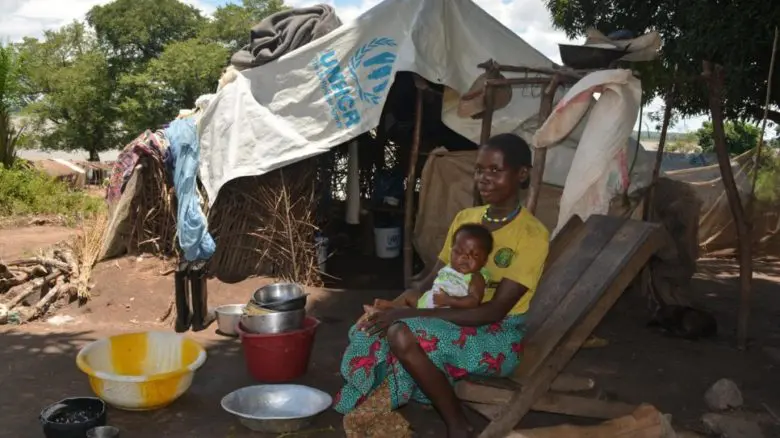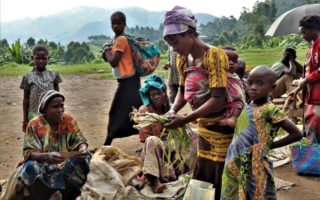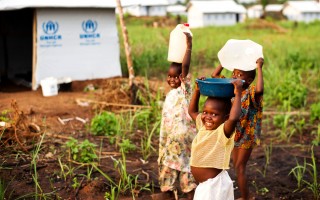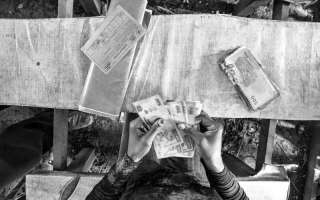
A refugee mother from the Democratic Republic of Congo sits outside a shelter with her baby in Toko Kota in the Central African Republic.
© UNHCR/Stella Fatime
By Stella Fatime in Toko Kota, Central African Republic
When thousands of people fled in canoes across a river into the Central African Republic as refugees earlier this year, they arrived in a tiny village whose residents had little to give.
Yet the villagers opened their hearts and their homes to the desperate newcomers from the Democratic Republic of Congo.
“I could not bear seeing children and their mothers sleep rough, even less so during the rainy season,” said Rachel, 39, a single mother from Toko Kota village who welcomed ten women and children into her home.
“We are all hungry. Finding something to eat is a real problem here and we drink water from the river. We don’t have much, but we are always hospitable,” she said.
In all, more than 3,000 Congolese refugees fled an attack on the town of Buda, in Congo’s Nord Ubangui province, in late May, for Toko Kota, a village on the Ubangui River in southern Central African Republic. Half are children and a further 30 percent are women.
“We are all hungry … But we are always hospitable.”
They are victims of conflict in a region that gains little international attention. The Central African Republic hosts just over 10,000 refugees, half of whom fled Congo. The country has around 641,000 internally displaced people, while another 619,000 have sought refuge in neighboring countries.
To help meet basic needs in Toko Kota, UNHCR, the UN Refugee Agency, distributed with 1,000 emergency kits containing plastic tarpaulin to build shelters, mosquito nets, mats, blankets, cooking utensils, jerry cans and buckets. UNHCR also distributed handwashing stations and soap, essential given the COVID-19 pandemic.
It took two days for the UNHCR convoy to drive the 500 km from the capital Bangui to the village over muddy roads and rickety bridges and through territory controlled by armed groups. At one point the convoy used a rickety ferry to cross a river.
“UNHCR is working closely with the Central African Republic authorities to ensure that refugees are registered and provided with emergency assistance. In times of Covid-19 pandemic, it is important to support the refugees and their hosts,” said Hamdi Bukhari, UNHCR’s Representative in the country.
UNHCR has received just half of the US$ 47.5 million it requires for its operation in the Central African Republic this year, so the operation is severely underfunded.
“We heard gunshots and screams of terror.”
The people from Buda arrived with almost nothing because they fled the May 23 attack using their dugout canoes to cross a river that borders the two countries.
“It all went very fast,” says Nadège, 37, who fled in a canoe with her two children. “We heard gunshots and screams of terror. I went out of the house and saw armed men entering our village.”
The river crossing proved treacherous in the dark. Several children are reported to have drowned and some families were separated. Nadege lost touch with her husband.
To survive, the refugees continue fishing, work in the fields with their hosts or return each day to farm in Buda. But they suffer, not least from the absence of health care. A three-year-old died for lack of treatment shortly after arriving in Toko Kota. In addition, there is no school.
UNHCR distributed tools essential for working the field for self-sufficiency, such as hoes, pickaxes or shovels, as well support growing food but needs remain great and the refugees say it is not safe to return home.
“It’s important to provide assistance to these refugees,” said Thierry Maximim Dogba, deputy mayor of the nearby town of Kouango. “Their needs are high, and our means are modest. We are calling for solidarity, for people to come to their rescue.”
Originally published by UNHCR on 13 October 2020.





